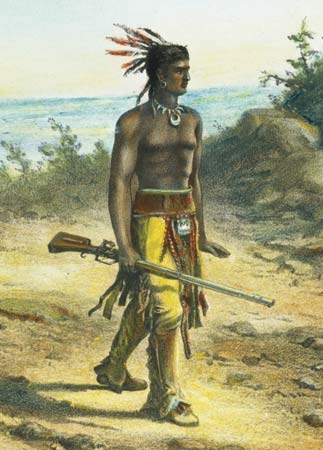Tisquantum, also known as Squanto, was a Patuxet man who assisted the Pilgrims after their first winter in the Massachusetts Bay Colony. He was integral to their survival. He was a member of the Patuxet tribe, a tributary of the Wampanoag Confederacy. He was enslaved and crossed the Atlantic Ocean six times, traveling with colonists to London and back.

Squanto's life is an amazing story of resilience and survival, and it is left out of the history books. We only get a snapshot of him in time, and it centers around the Pilgrim's Thanksgiving.
Jump to:
Squanto Facts: Early Life, Enslavement, and Return
- Squanto's date of birth is unknown, and was born in a Patuxet village near Plymouth Colony.
- According to most popular accounts, Captain George Weymouth was exploring the New England coastline for Thomas Arundell and Henry Wriothesley, 3rd Earl of Southampton, in 1605.
- Gorges captured Squanto and four others and brought them back to England. Weymouth landed in Plymouth and delivered three of his captives, including Squanto, to Ferdinando Gorges, governor of the fort at Plymouth.
- Gorges taught Squanto English so that he might serve as an interpreter on future voyages.
- Squanto returned to New England in 1614 with an expedition led by Captain John Smith. On his way back to Patuxet, he was abducted by Thomas Hunt, one of Smith's lieutenants. Hunt was planning to sell fish, corn, and captured natives in Málaga, Spain.
- He transported Squanto and a number of other Native Americans to Spain, where he tried to sell them into slavery for 20 pounds apiece. Franciscan friars discovered what Hunt was attempting, so they took Squanto and the other Native Americans to safety. The Friars instructed them in the Catholic faith.
- Squanto persuaded the friars to let him try to return home. He reached London, where he lived with John Slany, a shipbuilder for whom he worked for a few years.
- Slany taught him more English. He took Squanto to Cuper's Cove, Newfoundland, in 1617.
- To get to New England, Squanto tried to take part in an expedition to that part of the North American east coast, but Thomas Dermer sent him back to London in 1618 to meet Gorges and ask for permission.
- In 1619, Squanto finally returned to his homeland aboard John Smith's ship, having joined an exploratory expedition along the New England coast led by Captain Dermer.
- He soon discovered that the Patuxets and a majority of coastal New England tribes (mostly Wampanoags and Massachusetts) had been decimated the previous year by a plague, possibly smallpox.
Squanto Facts: The Pilgrims
- Abenaki sagamore Samoset was visiting Wampanoag Chief Massasoit, and he introduced Squanto to the Plymouth colonists near the site of his former village.
- He helped them recover from an extremely hard first winter by teaching them the native method of maize cultivation, which buried local fish (menhaden) in the soil to fertilize crops.
- In 1621, Squanto was the guide and translator for settlers Stephen Hopkins and Edward Winslow as they traveled upland on a diplomatic mission to the Wampanoag sachem, known today as Massasoit.
- In a subsequent mission for Governor William Bradford that summer, Squanto was captured by Wampanoags while gathering intelligence on the renegade sagamore Corbitant at the village of Nemasket.
- Myles Standish led a ten-man team of settlers from Plymouth to rescue Squanto if he was alive or, if he had been killed, to avenge him. He was found alive and welcomed back by the Pilgrims at Plymouth, where he continued in his vital role as assistant to the colony.
- Squanto worked at building alliances, but Massasoit did not trust him in the tribe's dealings with the settlers. He assigned Hobomok to watch over Squanto. On his way back from a meeting to repair damaged relations between the Wampanoags and Pilgrims, Squanto fell ill with a fever and began bleeding from the nose.
- Squanto died a few days later, in 1622.
